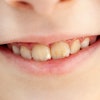Asthma medication use may not be associated with dental disease in children; however, having a dog during the first year of life suggests a reduced risk of enamel defects, according to a study published on October 9 in Pediatric Allergy and Immunology.
The finding that man’s best friend may cut this risk in children should be considered suggestive and warrants conducting more studies in the future. Furthermore, the study suggests a correlation between antibiotic use during pregnancy and an increased risk of enamel defects, the authors wrote.
“To our knowledge, this is the first study to investigate the impact of asthma and use of inhaled corticosteroids and β2-agonists on both caries and enamel defects in childhood, including exhaustive analyses on relevant early life exposures in a prospective birth cohort setting,” wrote the authors, led by Dr. Klaus Bonnelykke of the University of Copenhagen in Denmark.
It has been suggested that inhaled corticosteroids, β2-agonists, or asthma symptoms -- in addition to prenatal and postnatal factors, including maternal medication use during pregnancy -- are risk factors for dental cavities or enamel defects. Despite this association, there are a limited number of studies exploring these factors.
To better understand possible correlations, a prospective cohort study that included 589 children was conducted. Of these children, 61% received inhaled β2-agonists for asthma, with a mean number of 60 days of treatment. From ages 3 to 6, 11% used inhaled β2-agonists more than 12 days for one year, 4% more than 12 days per year for two years, and 1% for more than 12 days per year for all three years. Additionally, 31% were treated with inhaled corticosteroids within their first three years, and 34% during their first six years, according to the study.
The use of either asthma medication during the children’s first six years of life were linked to an increased risk of caries or enamel defects, the authors wrote.
However, other risk factors were associated with dental diseases in these children. Their mothers’ antibiotic use during pregnancy increased the risk of their children having enamel defects (odds ratio [OR]: 1.25, [1.01-1.54]). However, having a dog at home during a child’s first year of life decreased their risks of enamel defects (OR = 0.50, [0.27–0.93]), they wrote.
Previous studies have shown that gut microbiome development may affect the risk of allergy and asthma probably through immune modulation, and it could be that exposing kids to pets can change gut composition. This alteration may be a possible mechanism decreasing the risk of enamel defects, they wrote.
Nevertheless, the study had limitations, including that children’s dental hygiene was only assessed at age 6. This means that correlations between hygiene and dental outcomes could be due to reverse causation, they wrote.
“Early risk factors for enamel defects are still uncertain, but the possible inducing role of antibiotics in pregnancy and a potential protective effect of having a dog in the household should be addressed in future studies,” Bonnelykke et al wrote.




















